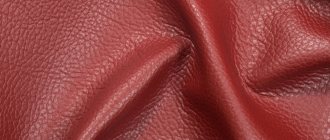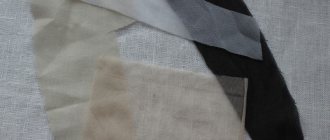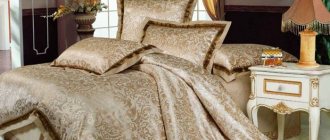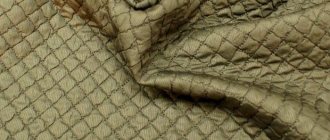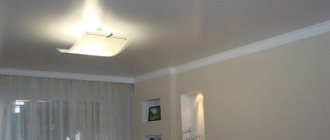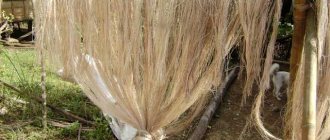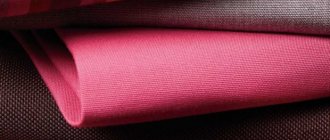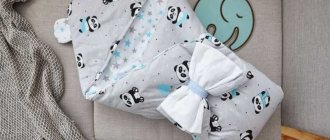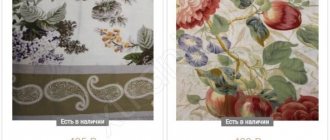Not many people can boast of good sound insulation in their home, except perhaps residents of Stalin-era houses. The rest have to listen to how the TV is working in the next apartment, how children are running, how repair work is going on, and much more.
To make the room as comfortable as possible, you need to take care of sound insulation. First of all, you need to pay attention to the windows - they must be multi-layered, with sufficient distance between the layers. But if the windows are already installed and there is no way to change them, you can use acoustic fabric.
It’s worth noting right away that this will not solve the problem 100%, but it will still significantly improve sound insulation and create a more comfortable atmosphere.
What is acoustic fabric?
Acoustic fabric is most often used as curtains. It differs from ordinary textiles in that it has additional properties that make it more practical to use. Plus, it works to improve sound insulation, which traditional curtains cannot do.
Acoustic fabrics can be used not only in the apartment. Libraries, clinics and hospitals, government agencies and any other premises where excess noise is undesirable. Reducing background noise from conversations, slamming doors, people walking and other work processes will make the atmosphere more pleasant.
Also, soundproofing fabric will be useful for owners of noisy pets that bark and meow loudly. In order not to listen to complaints from neighbors, it is enough to place a canvas made of acoustic fabric on the wall.
Varieties and areas of application
Currently, acoustic fabric is used not only for decorating sound speakers and other devices. When selling, there are at least two types of such materials:
- sound transparent;
- sound-absorbing.
The first category of paintings can be classified not only as sound, but also as decorative. Its main purpose is to shield the internal components of the equipment and protect them (especially the speaker cone) from mechanical damage. This sound-transparent fabric can be either very thin (resembling chiffon) or have the structure of a loose matting. The main requirement for materials in this group is the free and undistorted transmission of sound signals. However, since sound transmitting devices constitute a noticeable detail of the interior, such textiles also play a decorative function. It is selected in accordance with the design of the room, sometimes even painted as batik or images are applied photographically.
The main function of sound-absorbing materials is to absorb sound waves, primarily those that are reflected from the walls and create unwanted interference with the main signal. These are dense and thick canvases with a porous structure, which are placed on the walls of rooms or inside acoustic systems. Fabrics of this group are widely used in studios, concert halls, auditoriums, home theaters, as well as inside various acoustic equipment.
The use of sound-absorbing textiles has recently become one of the current trends in car design. Sound-absorbing upholstery has become one of the fashionable tuning ideas, and the variety of its colors and textures allows you to implement the most unexpected design ideas. The same applies to sound insulation of various premises, including residential ones. Sound-absorbing acoustic fabric on the ceiling, walls, and partitions will not only create comfort and the ability not to depend on too noisy neighbors, but will also become a real highlight of the interior . The variety of acoustic materials of domestic and foreign production, which are currently offered by online stores, as well as the possibilities of your own graphic design based on them, will allow you to realize the most daring ideas for the design of premises and radio equipment.
Material characteristics
Here are the main advantages of acoustic fabric:
- The ability to perfectly absorb airborne noise and reflect sounds. It is thanks to this ability that acoustic fabric is used for sound insulation.
- High material density. Compared to regular fabrics, this one is much denser. It is almost impossible to tear and quite difficult to damage in any other way.
- UV protection. Thanks to this feature, soundproofing fabric protects not only from noise, but also from excess light. For those whose windows face the sunny side, this is an excellent solution.
- Not afraid of dust. Thanks to special treatment, the fabric is not saturated with dust and therefore does not need frequent washing. To clean such curtains, just walk over them with a dry brush.
- Safe for children and pets. The fabric is made from environmentally friendly raw materials and is therefore safe for all family members.
- Resistant to chemicals. Thanks to this property, you can use chemical cleaning agents and not worry about the condition of the fabric.
- Large selection of colors. Thanks to the wide selection, everyone can choose the option that suits their interior.
Considering these points, acoustic fabric is much more convenient to use than regular fabric. Even if you do not suffer from poor sound insulation, curtains made from such fabric will also be useful to you.
Structure and properties of acoustic materials
The very first acoustic fabric was made from cotton and, less commonly, silk. The fabric was woven in a special way, which can be seen on old receivers and sound equipment. Modern materials for these purposes are made mainly from polyester.
Soviet acoustic material
The fabric can be woven in different ways, forming a mesh lattice, and have different colors: from white and black to multi-colored, and contain proprietary patterns that identify the manufacturer of the material.
Important! The density, texture and elasticity of the material may vary, depending on the purpose.
It is used to decorate audio and acoustic music systems, to create the effect of a favorable acoustic environment. Factories weave fabrics from threads of different thicknesses and shades. As a result, a huge number of textures are obtained. Some types are treated with special impregnation based on fire retardants to give them fire-resistant properties.
The main characteristics of this type of fabric are:
- High strength index;
- Wear resistance;
- Lack of reactions when interacting with most chemical compounds;
- Low hygroscopicity;
- High acoustic effect, transmission and reflection of sound signals;
- Certain types of fabrics are resistant to high temperatures and fire.
You may be interested in 100% polyester fabric: synthetic material or not
Transparent option
Types of fabric
Acoustic fabrics can be divided into two types, each of which is applicable under certain conditions. They differ in their characteristics and have certain features. By choosing different types of fabric, you can eliminate different problems.
- Sound-absorbing fabrics. Such fabrics are used as finishing material for walls in public places and for finishing car interiors. Their key property is the ability to absorb sound waves, reducing the overall noise level.
- Decorative fabrics. Used primarily for decoration. Most often, curtains and drapes are made from such fabrics or used to create decorative accents in wall decoration. This type of fabric comes in a huge variety of colors, so you won’t have a problem finding something suitable for yourself.
Modern manufacturers, understanding the needs of their clients, create and produce new types of acoustic textiles every day. Here are the most popular fabrics:
- Velvet. This material is already incredibly beautiful in itself. Thanks to its noble shimmer, velvet is used as curtains in classic interiors and wall decoration. In addition, velvet can be found in theaters, libraries, museums and so on. The long fibers of this material capture sound waves and dampen them, creating silence so you can relax or, on the contrary, concentrate on work.
- Blackout. This fabric is used primarily in the form of curtains. If your windows allow sounds from the street to pass through, such curtains can reduce the noise by a third. In addition, they have the ability to absorb light up to 90%, so if you want to relax and get a good night's sleep, just close the curtains.
- Multilayer curtains. This fabric has a wool layer on both sides, which is covered with polyester fibers. Thanks to this, it is very soft, but at the same time effectively protects both from excess noise and from unwanted sunlight.
Varieties
Today, acoustic fabric is actively used not only for decoration, but also for use inside devices. You can find at least two types of material on the market:
- Sound-transparent, that is, sound-permeable;
- Sound-absorbing.
The first type of canvas can be classified not only as a decorative one, but also as a sound one. Its main purpose was to shield the internal parts of equipment and protect them from mechanical damage, especially speakers. This fabric is acoustically transparent.
Sound transparent
Important! Sound-transparent fabric can be very thin and look like chiffon, or it can be thicker, like loose matting.
The main requirement for this type of fabric is the free transmission of sound without any distortion. Since sound devices play an important role in interior design, such fabric should be attractive and come in a variety of colors to suit the specific interior.
The main property of sound-absorbing fabric is the absorption of sound signals and waves, especially those that are reflected from walls and create interference with the main signal. This material is denser and more porous. It is ideal for placing it on walls in rooms where sound quality is important: recording studios, concert halls, home theaters. The use of such textiles in cars has become a trend in recent years.
Important! This kind of sound-absorbing material placed on the ceiling and walls not only creates comfortable conditions and protects from noisy neighbors, but is also a good design element.
Sound-absorbing
By variety, this type of fabric can be divided according to the material from which they are made, namely: velvet, blackout or multi-layer curtains.
Velvet
The most common material. Its advantages are the fact that it is pleasant to look and feel, and also perfectly absorbs sound signals. For acoustic purposes, you should choose thick and dense velvet with long pile. Most often it is used for finishing bedrooms, conference rooms, and museums.
You might be interested in what polyester is and how it differs from polyamide and nylon
Velvet
Blackout
Blackout protects not only from 90% of the sun's rays penetrating from the outside, but also soundproofs. It can be draped or used as curtains and curtains. Perfect for insulating bedrooms, darkrooms, cinemas.
Blackout
Multilayer curtains
Soundproofing curtains are made from several types of materials: wool interlayer or polyester. Today they do not necessarily have to be multi-layered, since types are being invented that transmit light well, but are acoustic and can replace curtains made in several layers. Such curtains are used not only in apartments, but also in public places, restaurants, and cinemas.
Curtains
Nuances you need to know
When using acoustic fabrics, there are a few secrets you need to know to ensure you get the maximum benefit.
- Drapery enhances sound insulation. If you hang curtains in frequent folds, this will almost double the soundproofing effect.
- Dry cleaning is preferred. Some types of acoustic fabrics do not like contact with water, as water can damage the protective layer. Try to dry clean curtains made from such fabrics.
- The right choice of acoustic curtains. When choosing, be guided primarily by your needs. If you are interested in both improving sound insulation and light protection, immediately select curtains that meet both criteria.
As you can see, acoustic fabrics are an easy way to help improve the ambience of a room by reducing noise. And thanks to the wide range, they can also decorate a home, office or any other room.
